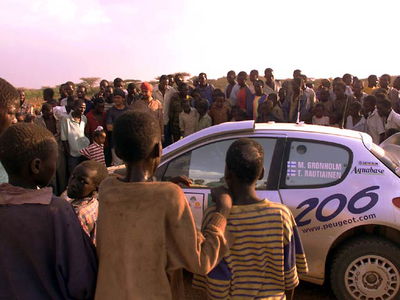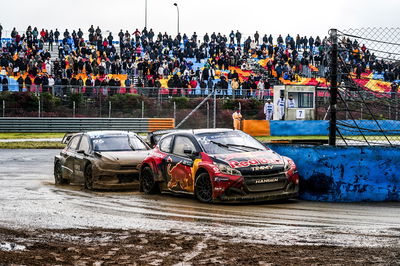Michelin aiming to reclaim Safari laurels.
''Nobody is more determined than I am to see Michelin build on its record of seven Safari wins since 1991''.
These were the words of Pierre Dupasquier, director of Michelin's competitions department, at the finish of the 2000 Safari Rally, after his firm's products had failed to take the laurels in the African classic for only the third time in a decade.

''Nobody is more determined than I am to see Michelin build on its record of seven Safari wins since 1991''.
These were the words of Pierre Dupasquier, director of Michelin's competitions department, at the finish of the 2000 Safari Rally, after his firm's products had failed to take the laurels in the African classic for only the third time in a decade.
Just as eager to put last year's disappointment behind them, Michelin's research engineers have effectively been hard at work over the past sixteen months, developing a new evolution Kenya tyre that combines the necessary robustness and high performance to overcome the difficulties inherent in the country's uncompromising terrain.
At the same time, the firm's manufacturer-partners entered on this year's event - Mitsubishi, Peugeot and Skoda - have been busy optimising the way their respective transmissions and suspensions work with their tyres. Indeed, their engineers know as well as anyone that the way tyres perform is highly dependent on the quality of their 'working environment'.
In the build up to the 2001 Safari, Michelin and its partners have covered literally thousands of kilometres in private testing. However, nobody can ever claim to be 100 per cent Safari-proof. Even the most thoroughly prepared assaults on this punishing rally can be quashed by the countless hazards that are part and parcel of the event, and which co-drivers cannot hope to call in their entirety.
Yet meticulous preparation remains a precondition for success in Kenya and Michelin, in its bid to return to its winning ways on the toughest round of the calendar, has done all in its power to leave absolutely nothing to chance.
Like any tyre, World Rally Championship rubber has to fulfil a certain number of functions: grip, absorption, steering, transmission and resistance. To be competitive, it must of course combine all these roles. However, the specificity of each round tends to put the spotlight on one or sometimes two of these functions.
The Safari has always been a case apart in the WRC. The long portions covered at high speeds - sometimes more than 200kph - combined with the exceptional length of the stages, the heat, the special features of the cars and the concentration demanded of the drivers combine to make this event a very different challenge. On top of that, the combined effects of these extreme conditions are exponential.
Specific, thorough car preparation is vital and every part of the transmissions and suspension chains must be perfectly up to the job. The final link in each of these chains is the tyres which have to carry an extra load of approximately 10 per cent compared with a 'European' specification car, and a perfectly tuned 'working environment' is necessary for them to carry out their mission effectively.
Even with the most carefully built car, running gear performance can be compromised by the knocks that are practically inevitable here. In such cases, the strain on tyres is clearly amplified. Indeed, along with 'pinching' (vertical shocks) and sidewall damage, deterioration of the tyres' environment is a major cause of the sort of tyre-related 'incidents' that can occur on this hostile terrain.
Tyres need to be strong therefore, but not to the detriment of overall performance and, in their bid to build on the firm's seven Safari wins since 1991, achieving this balance has been the priority of Michelin's research team since last year's event. This work has naturally been carried out in close collaboration with the engineers of their manufacturer-partners' who fully understand the influence tyre characteristics have on the overall specification of their cars.
The special demands and conditions encountered in Kenya dictate the use of reinforced products and the availability of the maximum width and diameter permitted by the regulations. The objective is effectively to obtain the biggest volume of air inside the cover with a view to optimising the obstacle-crossing capacity of the Safari tyres. The tread blocks of both these products are particularly rigid in order to limit their mobility on aggressive stage surfaces, while the bolder pattern of the Michelin ZB is aimed at harder wearing stages.
Michelin has a total staff of 18 in Kenya. The total number of covers available for the event is approximately 1100 shipped out to Africa by boat and plane. Only those tyres used for the shorter competitive sections will be fitted with Michelin's ATS system (Appui Temporaire Souple).
The 2001 Safari Rally stays with the format of legs one and three based on Whistling Thorns to the south-west of Nairobi, plus a longer second leg straddling the Equator at Equator Park. With a total distance of close to 3000 km and with over 1100 km of so-called 'competitive sections' - to distinguish them from the traditional European-style 'special stage' - this is by far the longest round of the WRC calendar.
Until recently, the Safari was organised over the Easter weekend but a few years ago it switched to a new slot at the end of February/early March. This year sees the event organised for the first time in July, a move that could well ensure cooler, more settled weather conditions. However, the possibility of rain can by no means be dismissed. And when the going gets wet, the region's red laterite tracks become extremely slippery and are often referred to as skating rinks by drivers. One of the particularities of the event is that it takes place on roads open to normal traffic. Average speeds are usually very high - that of last year's winner was more than 122kph.











